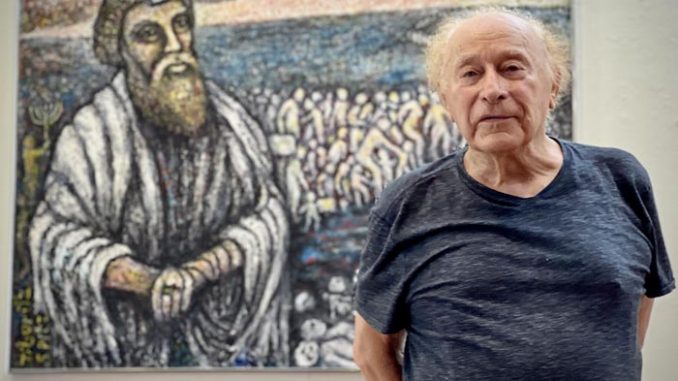
Tibor Spitz, 93, is an artist from Czechoslovakia. His art often depicts emotions of despair, hopelessness and grief. Spitz is a holocaust survivor and creating art has helped him cope with the horrors of the genocide. On Sept. 13, SUNY New Paltz students were given the opportunity to hear him talk about his experience during and after the war.
The talk was hosted by the New Paltz Chabad. Rabbi Moshe Plotkin welcomed Spitz and spoke of the importance of learning about the Holocaust. Addressing the Jewish students in the audience he said, “we’re not Jewish because he tried to kill us. He tried to kill us because we’re Jewish. Judaism goes way beyond remembering the Holocaust… we remember the things that have happened so we can make sure that they never happen again.”
Second year student Sophia Lattof attended the talk and had similar feelings. “Holocaust survivors are all dying, and it’s important to listen to their stories and learn from mistakes that people made in the past, so we are not doomed to repeat them,” she said.
Spitz began talking about the history of the Jewish faith and the history of antisemitism in Europe. He was forced to leave school at the age of 10 for being Jewish. Two years later, his friends and family began to be shipped away to concentration camps. As it said on a slideshow spitz projected to the audience, he and his family had to make a choice: “Remain passive and be killed; to revolt and be shot on the spot,” or “try to survive against all odds and become witness of this crime.” They decided to fight to survive.
Spitz and his family built a shelter in the woods with a few small tools and managed to make it through seven months. The shelter was dug out and held stable with tree trunks. Even though they escaped death at the concentration camps, they still had to look out for Nazi patrols storming through the woods.
Spitz and his family managed to survive through April of 1945 when allied troops liberated Holocaust survivors.
Abby Hedler, a second-year environmental studies student who attended, found the talk especially eye-opening. “You hear a lot of stories of people from France or Germany or Poland, so it’s interesting to hear the experience of someone from a smaller nation, but his experience was just as valid as that of a larger nation,” she said.
At age 15, Spitz went back to school despite being illiterate. He learned quickly and had ambitions of becoming a sculptor. His plans were interrupted with the ever so changing post-war world.
His school in Prague recruited him as a chemist for the Soviet government of Czechoslovakia and by 1949 he had a PhD in chemical engineering. Spitz was sent to Cuba on a two year assignment, working at three different glass factories. He and his wife relocated to Montreal, Canada, where he was the Chief Chemist and CEO of multiple glass factories.
The Québécois separatist movement worried Spitz that Canada was becoming “soviet friendly.” So he came to the U.S. with his wife and moved from state to state until they eventually settled in Kingston, New York. He retired after working for National Micronetics for 14 years.
It wasn’t until he was 68-years-old that he became an artist. He studied painting, drawing and sculpting at Ulster County Community College. Spitz began to use his art as a source to share with the world what he went through. He continues to be an inspiration to artists today because he shows how art can help people rise above their hardships. “My survival required a reaction to action,” he said. His art continues to be his reaction.
